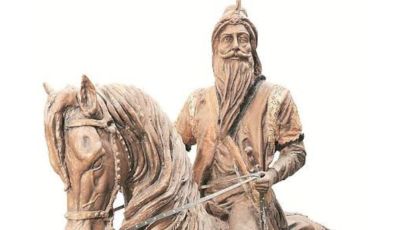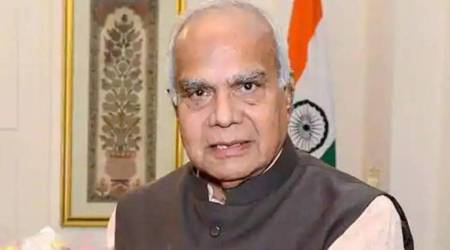I am reproducing here with an excellent note written by my friend Sardar Gunbir Singh a famous writer from Amritsar in his Column ‘Amritsar Calling’published in Indian Express.
Amritsar Calling: A city loved by Maharaja Ranjit Singh
For a ruler to have inscribed “That the Guru in an abundant act of mercy, upon regarding him as prime Sikh servitor, bestowed upon him the privilege to serve Sri Darbar Sahib,” is indeed an endearing statement of humility.

Amritsar revels in the legacy of Maharaja Ranjit Singh. His love for the city is legendary, and he ensured a significant presence here despite the demands of his vast kingdom including his Durbar at Lahore.
In contemporary times, there is no greater edifice to this reverence for Ramdasspur, than the imposing black statue of the Maharaja on horseback atop the Shimla Pahadi, the hillock on the western corner of his summer retreat.
Trudge up to it and dwell upon the grandeur of His Majesty astride his handsome steed, gazing in the direction of the Harimander that he had embellished with bullion, thus ensuring the resplendence of this sacred shrine for times to come. The Maharaja’s humility towards this service is inscribed atop the doorway, at the threshold of the Golden Temple thus,
” … Sri Maharaj Guru Sahib ji neh, apne paran sevak Sikh jaan kar, Sri Darbar Sahib ji ki seva Sri Maharaj Singh Sahib Ranjit Singh par daya kar ke karayee…”
For a ruler to have inscribed “That the Guru in an abundant act of mercy, upon regarding him as prime Sikh servitor, bestowed upon him the privilege to serve Sri Darbar Sahib,” is indeed an endearing statement of humility.
Remarkable further still is his acceptance of Miri (Temporal power) & Piri (Spiritual power) as absolute dictates of the Guru himself. He even regarded himself as subservient to the temporal power vested in the Akaal Takht, despite being the ruler of Northern India.
Angered by the Maharaja’s misdemeanours, the Jathedar Akali Phula Singh, head of the Takht, the epicentre, summoned him. Leaving aside his trappings of a ruler he submitted himself as a humble Sikh and accepted the harsh punishment, Tankhaa, levied upon him. Such was his disposition.
The Ram Bagh
There is no place in India where one can see the presence of this great Emperor sizably other than in Amritsar. His Summer Retreat unscrupulously rechristened Company Bagh by the British and later Ram Bagh Gardens is presently being restored at a snail’s pace under the ASI. The baradaris, the gardens, and the exquisite architecture are a treat to the eyes.
The incursions of modernism in the aesthetically unmatched construction of the panorama, where statues on ‘mules’ as well as intrusions of commercial establishments are eye sores. To top it all many a politician has tried to prove his mettle by requisitioning some “insane” development that all but mars the original beauty and aesthetic of this retreat.
The people’s king
The other day I reached out to Khola Cheema to congratulate her on the remarkable presentation that she gave on BBC elucidating why, despite omissions in history, Maharaja Ranjit Singh is remembered with affection even today across the Radcliffe line.
She acknowledges, through her peer-acclaimed research papers, that on the day of his birth, his father won a war, thus he named his newborn Ranjit, the winner of all battles. At age 10 he had already won his first battle. By age 17, says Cheema, he had defeated the Afghan invaders under Shah Zaman. He did that not once but twice, one time at the periphery of Amritsar city.
North India at that juncture was in turmoil, ruled by Misls who had fiefdoms, defiled by marauders and iconoclasts. Even the citizens of Lahore were sick of the three kings who had divided the city.
The people wrote and invited this teenager to save them. It is said that he literally walked through and took over the city in 1799 without resistance or violence. Mandirs, masjids, gurdwaras, and in fact, the entire populace illuminated the city without solicitation.
Ranjit Singh was coronated Emperor in 1801, but he refused to sit on the throne of earlier wicked rulers and even held his Durbar at the Diwan-e-Aam rather than the Diwan-e-Khas. He thus became a people’s king with want to keep close to them and listen to their woes.
He was a ruler like none other. In his army were a French General and Italian mercenaries, European Generals Ventura and Allard, and even an American Colonel. His courtiers included Fakir Nooruddin, Dina Nath, and Hari Singh Nalwa. Thus, this Sikh ruler was inclusive to the hilt and had the support and love of his entire populace, one that comprised mostly Hindus and Muslims, who constituted 80 percent of his empire.
His utopic domain became a literary haven, where the arts proliferated, faiths prospered in unison and commerce was a prolific vocation. Amritsar under his tutelage became the most bustling city of Punjab. The Maharaja even established his mint, Taksal, in Katra Hari Singh in the heart of Amritsar. The currency of the Khalsa Sarkar produced here was12/13 times stronger than the British pound at that time.
The educationist
It is interesting to hear Englishmen talk about Ranjit Singh on British Broadcasting Corporation singing paeans to him as perhaps the greatest king ever. A king that signed the Treaty of Amritsar in 1809, thus restricting the English proxy forces, the British East India Company’s armies, to peninsular India beyond the River Sutlej whereas the rest of India succumbed.
Said Charles Metcalfe in the British parliament after signing the Treaty, that there are learnings here we must apply in Britain. They keep time and schedules, he marveled, even the spiritual centre Harmandir sahib has solar watches.
The melodies of the temple change as per the hour of the day. Each village has a volunteer force for self-defence, with a democratic decision-making power to plan and defend its own security. He said that there was a school in every village. Ranjit Singh has made a policy decision that each child in the kingdom would be educated.
All spiritual institutions, be it a Mandir, Sikh Dharamshala, Madrassa had to have a school attached. A Qaida system to teach the Punjabi alphabet was put in place. By 1830 every child, every adult, and every elderly were literate he later quoted. It is interesting to note that Britain established its Elementary School Act in 1870.
After curbing the British to the outer bank of the Sutlej, The Khalsa Sarkar thus expanded Northwards across the vast plains of the Indus Valley and beyond. This Maharaja was no usurper but a synergizer, one who believed in common causes, inclusion, and a visionary approach to governance.
At a time of iconoclasts, invaders, and tyrants here was a young lord who slowly but surely assembled the misls, the races, and the faiths into an empire that stretched from the Sutlej to Tibet, Gilgit Baluchistan to Kashmir down to Multan, the Khyber down to the Arabian Sea.
Qila Gobindgarh is another bastion of the Maharaja at Amritsar which is spectacular. It was the Toshakhana at this Fort where the Kohinoor and a bulk of the riches of the times were safe kept. This fort also once housed Zamzama, the greatest cannon of the times.
There are other equally romantic influences to be seen especially closer to the border that most people miss out on. Pul Kanjri is one such delight. Restored to its original glory through initiatives by dear friends Willie and Manveen, God bless their souls, it is a treat to the eyes. Built for his favoured courtesan, Moran, it houses a bathing ghat for her, hidden behind a terracotta mesh, a frescoed mandir, and a water storage system. Further down next to the border fence is a baradari built by him as well, which, left to the local hukmaraans, is all but lost.
There are so many endearing tales of his disposition towards his populace. An interesting story of a woman rubbing her utensil against the king’s feet as he was riding through a village. On being reprimanded she said he is known as Paras, one with the Midas touch, and thus she wondered if her utensil would turn to gold. The Maharaja asked the woman to be released and ensured that her home had enough utensils and grain for times to come.
And the one regarding the kids who were knocking off mangoes from a tree, and one of the rocks that missed the target and hit Ranjit Singh as he rode past. The boys were brought forth for punishment. Upon hearing of the accidental cause, the Maharaja excused them and instead made his column collect hordes of mangoes for the boys’ families. He is known to have remarked that if a tree being struck by stones can give people fruit, he must also do so.
It is shocking that the irresistible fables of his lifetime, narratives of his benign rule, his firm resistance to invaders and the British, and his sway over the entire northern subcontinent have not found their way to the screens of the world or even Indian celluloid. One sees the makings of international acclaim by a stalwart director who can create a series on his life. This one, Guneet Monga and Gurinder Chadha, is for the Oscars for sure, and the makings of which shall be a source of pride beyond lifetimes.
Meanwhile, we, the blessed citizens of Amritsar, the Praja, revel in the legacy of the Maharaja, the Sher-e-Punjab, and his fondness for this city that was founded by his Guru.
(The writer is an Amritsar-based environmentalist, philanthropist and historian who loves all thing






